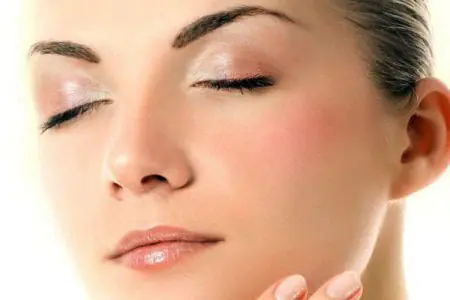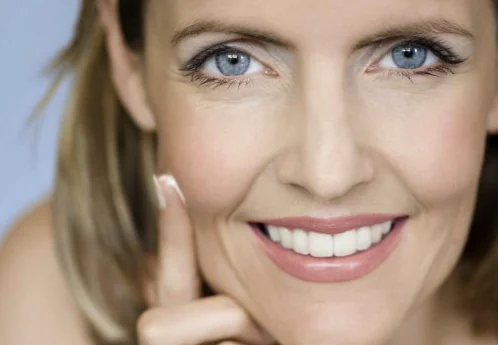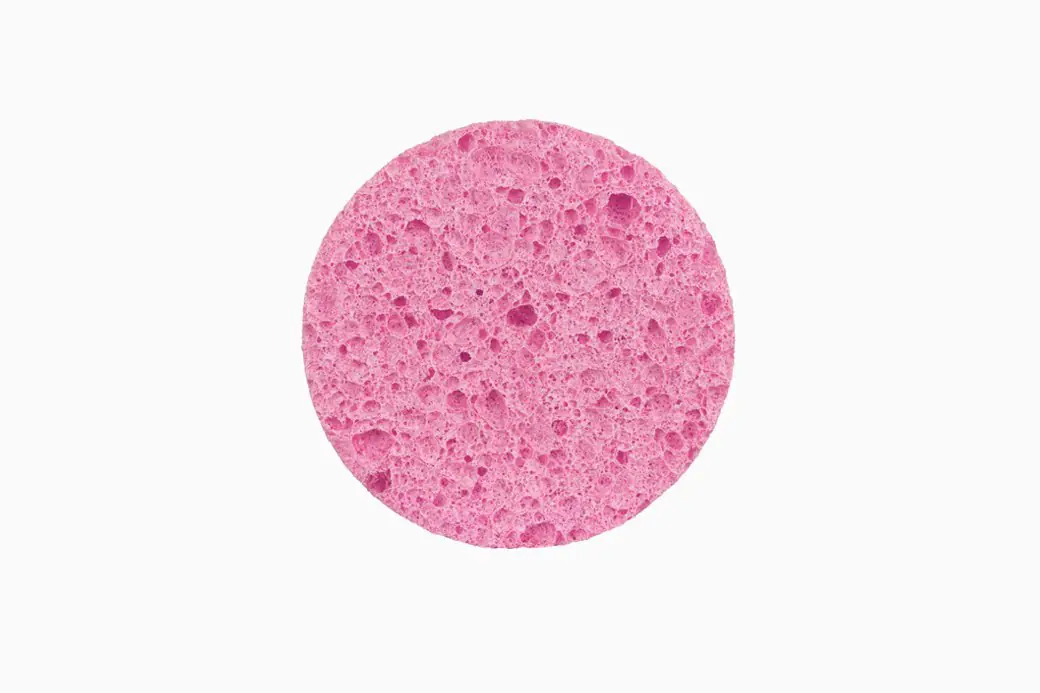Hormones, as we all know, are chemical substances that have a strong effect on the body, regulate metabolic processes and have a specific effect on various body systems. But how often do we ask ourselves that skin problems are related to hormones? When we talk about hormones, we mainly mean reproductive ones, although these are not the only hormones whose effects can be seen on the face.

Types and effects of hormones
ADRENALIN makes you feel full of energy. Known as the "fight or flight" hormone. Produced by the adrenal glands in stressful situations. The adrenal glands are supposed to release this hormone only sporadically, but modern, stressful lifestyles cause adrenaline to be produced regularly, causing the adrenal glands to become exhausted. Then the lack of adrenaline will be compensated by the overproduction of cortisol and testosterone.
CORTISOL – a hormone that is always present and leads back to adrenaline. Cortisol increases the acuity of all senses and makes you ready for “fight or flight” and has an inflammatory effect on the body.
SEROTONIN – hormone of happiness. Helps you feel calm and relaxed and regulate your appetite. To ensure a sufficient amount of serotonin in the body, it is necessary to get enough sleep, since it is during sleep that this hormone is produced. So if your client doesn't get enough sleep due to stress or hot flashes at night, they will suffer from a lack of serotonin. Low serotonin levels also lead to a lack of melatonin.
MELATONIN works “hand in hand” with serotonin and allows you to sleep peacefully at night. Good sleep allows you to wake up with a sufficient supply of adrenaline and serotonin.
INSULIN responsible for sugar levels.

If the adrenaline supply is depleted, the person begins to act on cortisol, and the skin then becomes inflamed. You can forget about deep sleep - melatonin and serotonin will be at different levels, which means you will feel tired, exhausted and lethargic. In this case, most likely, a burst of energy will help, which will stimulate the production of insulin, which will lead to stress relief and activation of the adrenal glands.
This is how the hormonal “carousel” starts. These hormones will bind to reproductive hormones present in the body,
Reproductive hormones
Hormones, as we know, are chemical “messengers” that have a specific effect on certain cells of the body. They enter the bloodstream, through which they are delivered to various parts of the body. But they only affect those cells that have a specific, unique structure specifically for this type of hormone. Therefore, hormones have an effect only if they enter the correct receptor. The skin has several types of receptors for different hormones:

- ESTROGENIC HORMONES of female action;
- ANDROGENIC HORMONES of male action;
- PROGESTERONE is a precursor of androgens and estrogens. Has a regulatory effect.
How do hormones affect the skin?
ESTROGEN:
- Stimulates cell growth and turnover.
- Reduces the size and activity of the sebaceous glands.
- Makes sebaceous secretions less viscous.
- Increases fat reserves.
- Retains fluid in the body.
- Disturbs blood sugar levels.
- Leads to a decrease in zinc.
- Reduces the supply of oxygen to cells.
- Stimulates the production of hyaluronic acid.
- Leaves skin texture softer and calmer.

The effect of estrogen on women's skin is obvious. The regulating effect on the sebaceous glands means that a woman’s skin will be much less oily than a man’s. Estrogen also stimulates the production of hyaluronic acid, which not only keeps the skin soft and smooth, but also achieves optimal moisture levels. Estrogen production changes over the course of life. At the same time, our skin also changes.
ANDROGENS:
- Increases the number of cells in the basal layer.
- Increases the activity of the sebaceous glands.
- Increases the viscosity of sebum.
- Stimulates collagen production.
- Increases hair growth.
The behavior of the sebaceous glands is regulated by hormones. Men have higher levels of androgenic hormones than women - this can be seen if you compare the skin of different sexes. Because androgens increase the viscosity of sebum, men's skin is oilier and their pores are enlarged. Androgens stimulate fibroblast cells to produce collagen, resulting in thicker, firmer skin.

PROGESTERONES:
- They interfere with the functioning of estrogen receptors.
- Provide cells with oxygen, thus strengthening the skin.
- Stabilizes sugar levels.
- Normalize the content of zinc and copper.
Taking into account all the effects described above, let's take a look at the different conditions of our skin according to the periods of hormonal changes.

Pimples (acne) and hormones
This effect is one of the most undesirable. Its grade can vary from one pimple to huge cystic acne (grades 1-5).
Acne is the result of poor quality sebum, extreme thickening of the stratum corneum, disruption of skin microflora or inflammation. We know that androgens affect two of these factors, increasing the rate of basal cell turnover (skin thickening, congestion) and sebum viscosity (food for bacteria, inflammation).
This leads us to believe that everyone who suffers from acne has high levels of androgen in the blood. However, it is not. The issue is complicated by the fact that we must take into account the following fact: the ovaries and adrenal glands produce only 50% of the total amount of androgens in the body. The remaining half is produced directly in the skin, and the skin can also convert already produced androgens into a more potent form. But how?

The lower part of the sebaceous gland contains an enzyme that is especially sensitive to androgens. 5A reductase enzyme converts androgens into a very powerful testosterone called dehydrotestosterone. It increases the viscosity of sebum. To treat such skin, it is necessary to find an ingredient that will regulate the activity of sebocytes (sebaceous gland cells), such as vitamin A in the forms of retinyl acetate and retinyl palmitate and in a dosage high enough to achieve results.
Premenstrual acne
During the first half of the menstrual cycle, estrogen dominates and controls the sebaceous glands. After ovulation, progesterone begins to dominate, and estrogen returns to its normal effect on the glands. Androgens help mask the effects of estrogen by thickening the skin and making the secretions of the sebaceous glands more viscous.
And this in turn leads to inflammation and acne. If your client suffers from this, the diagnosis is obvious - cutaneous estrogen deficiency. Treatment requires an ingredient that stimulates the production of phytoestrogens and adaptogens, which help cells recognize these substances.
Menopause
Hormonal changes during menopause occur slowly unless they are caused by surgery. Menstruation becomes irregular, ovulation decreases until it completely disappears. Many interesting things happen at this time. Progesterone stops being produced because there is no more ovulation. The ovaries reduce estrogen production. Androgens continue to be produced at the same level.

Thus, the influence of testosterone becomes more obvious. Unopposed testosterone causes hair growth and acne (as well as changes in body shape). Lack of estrogen causes a decrease in the production of hyaluronic acid, which means the skin becomes thinner and almost unable to remain hydrated.
Remembering that estrogen is no longer produced by the ovaries and that there are receptors in the skin that are supposed to accept estrogen, we can conclude that an ingredient that stimulates the production of phytoestrogens is needed. In this case, you will notice improvements within a few days.
Listen to the audiobook of this article
Be healthy and beautiful! Your Super Cosmetologist!
Causes of acne
Types of acne
Read also
Types of retinoids
Read also
Eyelash growth products
Prostaglandins for the growth of long eyelashes
List of prostaglandins
We analyze eyelash growth products by ingredients
Read also
Hormones, skin condition and well-being
How do hormones affect the condition of our skin and well-being?
Hormones are an important thing. It is on their level and ratio in one particular organism that the reproductive function, that is, reproduction, growth, development, sexual desire, appetite, our mood and even good sex, depends. In a word, all life passes under the rule of hormones. Normally, a woman’s body contains the hormones androgens (they are also called male) and estrogens (i.e., female), naturally, women have much more estrogens, which are actually responsible for reproduction.
The beauty of our skin largely depends on the hormonal background. If you observe your skin according to the days of the menstrual calendar, you will notice that the skin changes depending on the phase of a woman’s menstrual cycle.
What are hormones and where do they come from?
Hormones are the most important biologically active substances involved in the regulation of all body functions. They are synthesized in various parts of the endocrine system, distributed throughout the body - the pituitary gland, hypothalamus, thyroid gland, adrenal glands, gonads, etc. Sometimes the target cells are located next to the organ that produces the active substance, but more often they are significantly removed. Blood vessels deliver the secretion products of the humoral system to the site. With their help, compounds quickly penetrate into the desired tissue and change the intensity of cell activity.
Androgens, skin condition and well-being
Originally, androgens are considered male hormones. But this does not mean that they are not present in the female body. The main representative of this group is testosterone; it is by its level that the doctor judges the entire group of androgens.
How they are synthesized: They are derivatives of the adrenal glands and gonads - female ovaries and male testicles. For the synthesis of such compounds, cholesterol is necessary, which enters the body with food or is formed in the liver from amino acids, glucose and other substances. In the adrenal glands, this process is regulated by adrenocorticotropic hormone (ACTH), and in the gonads by luteinizing hormone (LH).
Effect of androgens on the skin: Male sex hormones androgens play a significant role in the functioning of the skin.
Androgens act on skin cells through special receptors that are located in the epidermis, dermis and hair follicles. They regulate the intensity of cell division, the processes of differentiation, secretion and keratinization. In old age, there is a decline in hormonal synthesis, as a result of which the regeneration of skin layers slows down, protective functions decrease, and elasticity and attractiveness are lost. The opposite picture is observed during puberty and immediately before menstruation (especially with PMS).
A larger amount of androgens in the body are in an inactive state due to association with special proteins. In the presence of hormonal pathologies, the synthesis of such proteins is reduced, which leads to an increase in free active androgens. This has a very strong and very negative effect on the skin. Diagnosing such a condition is quite difficult, since there is no increase in the concentration of hormones in the blood, which is the main indicator of pathological processes in laboratory tests.
Puberty and androgens: Active changes in the body during intensive growth require increased production of androgens, as a result of which the sebaceous and sweat glands are stimulated, the rate of keratinization increases, and the composition of sebum changes. Before menstruation, there is an increase in the level of steroid hormones - androgen precursors. The tendency to hyperactive hormonal synthesis is hereditary in nature and can be clearly seen in close relatives. Various pathologies in the endocrine system - diseases of the pituitary gland, adrenal glands, male and female genital organs - can also influence its intensity.
Menstrual cycle and androgens: An increase in the level of steroid hormones is observed in the last phase of the menstrual cycle, about 70% of women notice the appearance of acne 2-7 days before menstruation. In this case, 5 alpha reductase (an enzyme contained in the sebaceous gland) converts testosterone into dihydrotestosterone, which directly affects the rate of cell division of the sebaceous duct. As a result, the skin becomes oilier in the first phase, zonular keratosis and isolated rashes in areas of wide pores may appear.
The function of androgens in the body: influence the development of secondary sexual characteristics, skeleton and muscles, the functioning of the sebaceous glands, are responsible for the process of follicle development, and stimulate sexual desire.
Increased androgen levels: may indicate adrenal hyperplasia or the presence of a tumor in the body, which in most cases also produces testosterone.
Decreased androgen levels: may indicate renal failure, prostatitis. Characteristic for people with Down syndrome. It is also possible when taking certain medications.
How to suspect an excess of androgens: irregular menstrual cycle, excessive dry skin, irritability, the appearance of purely masculine characteristics in women (hair on the face and chest, deepening of the voice), activity, including sexual activity.
How to suspect a lack of androgens: lack of sexual desire, irregular menstrual cycle, excessive sweating, oily skin.
Recommended skin care and cosmetic procedures: If, as a result of an excess of androgens, you have oily skin with periodic rashes, then it is not very correct to carry out aggressive procedures, such as skin cleansing and various peelings, at the beginning of the cycle, since the rate of sebocyte division is high and there are more chances get inflammation of the sebaceous gland.
Estrogens, skin condition and well-being
Estrogen is a sex hormone that gives women a feminine figure and feminine character. This group usually includes three main hormones - estradiol, estrone, estriol. Estradiol is the main and most active female sex hormone in humans; estrogen.
The menstrual cycle and estrogens: in the preovulation phase of the menstrual cycle, the concentration of the hormone estrogen (good for the skin) increases, so the woman blossoms, a powerful erotic magnet turns on inside her, attracting men. According to nature’s plan, at this moment she must act as a conqueror of men’s hearts in order to conceive a child from the most worthy of all applicants.
The effect of estrogen on the skin: Estrogen has a very good effect on the condition of not only the skin, but also the entire body - it is able to accelerate the renewal of cells throughout the body, maintain youth, shine and health of hair and skin. Estrogens sharpen the mind, invigorate and tone, strengthen the immune system, lift the mood, awaken sexual fantasies, encourage flirtation and coquetry, burn excess fat, prevent the deposition of cholesterol in the walls of blood vessels, make the eyes shine, smooth out wrinkles, make the skin elastic and firm, and we with you – irresistible and desirable.
The function of estrogen in the body: affects the work and development of the genital organs, mammary glands, bone growth, and determines libido. Together with progesterone, they are the main “controllers” of pregnancy and childbirth.
Increased estrogen levels: This is one of the main causes of excess weight. The doctor monitors the amount of estrogen in pregnant women especially carefully. Its elevated level may indicate a threat of miscarriage, fetal pathology, or intrauterine infection. Also, a jump in estrogen levels can cause pre-tumor and tumor conditions.
Decreased estrogen levels: threatens with excessive hair growth, deepening of the voice, and lack of menstruation.
If a woman in the second half of the cycle experiences a loss of strength, decreased performance, bad mood, insomnia, a possible cause of this condition is estrogen deficiency. The ability to grasp the essence of any problem on the fly, good memory, clarity of thought, optimism, the ability to show flexibility and adapt to rapid changes without worrying about the future - all this is a generous gift of estrogens to the female body. When their level decreases, the colors of the world fade, hands give up, weakness, absent-mindedness, nervousness, increased anxiety, apathy, and indifference to appearance appear. There is no way to put up with this!
Vitamin E (tocopherol), which should be taken an hour after breakfast, 0.4 g, as well as a creamy carrot cocktail (150 g of freshly squeezed carrot juice and 50 g of cream), will help increase the production of estrogen.
How to suspect that you have an excess of estrogen: Shortness of breath, heart problems, bright red-blue veins on the legs, sudden weight gain.
How to suspect that you have a lack of estrogen: your hair color has become darker for no reason, there is a constant feeling of hunger, the appearance of male characteristics in women (hair growth, deepening of the voice), decreased sexual activity.
Recommended skin care and cosmetic procedures: In the pre-ovulation phase of the menstrual cycle, when the concentration of the hormone estrogen (good for the skin) increases, the skin responds very well to any cosmetic procedures: masks, peelings, facial cleansing. Any manipulation of the skin will only benefit it. Cleaning and any more aggressive procedure is carried out precisely in the first half of the cycle.
Weight loss and estrogen: If you are losing weight, obesity can be managed by increasing physical activity, limiting calorie intake and cutting down portions slightly. Your task is to lose 2-3 kg in a month. Then you will be able to compensate for the hormonal decline. The fact is that the body stores estrogens produced by the ovaries during life for future use in the subcutaneous tissue. When you lose weight, they enter the bloodstream, bringing a feeling of lightness in the body, shine in the eyes and a tightening effect (estrogens tighten the skin in thin areas, preventing it from sagging in unsightly folds).
Luteinizing hormones (LH), skin condition and well-being
Doctors call this group of hormones LH for short. They are quite specific and their level for each person must be determined individually, since its fluctuations can be influenced by many factors, from playing sports to the next cigarette.
Function: help the formation of follicles in women. At the peak of the increase in LH, ovulation occurs. LH helps the formation of estrogen (good for the skin).
Increased levels: problems with the pituitary gland, including malignant tumors, polycystic ovary syndrome, endometriosis, kidney disease.
Decreased levels: disorders of the pituitary gland, genetic diseases, anorexia.
How to suspect you have an excess: headache, shortness of breath, general malaise, problems with the menstrual cycle. The same symptoms may occur as with an excess of estrogen, since LH helps the formation of estrogen, and as a result, the latter will be produced in greater quantities.
How to suspect a deficiency: problems with the digestive tract, excessive thinness or vice versa - obesity, irregular menstrual cycle; The same symptoms are possible as with an excess of estrogen.
Follicle stimulating hormone (FSH), skin condition and well-being
Abbreviated as FSH, it is fundamental in the formation of libido, helps the formation of estrogen (good for the skin).
Function: It is the level of this hormone that determines our sexual appetites - in both men and women. Regulates the functioning of the sex glands, is responsible for the formation of eggs, follicle formation and estrogen formation. At the peak of the increase in FSH, ovulation occurs.
Increased levels: can occur due to uterine bleeding, alcoholism, kidney disease, pituitary tumor.
Decreased levels: may indicate polycystic disease, diseases of the pituitary gland and hypothalamus, and the reproductive system.
How to suspect that you have an excess: absence of menstruation for several months or bleeding regardless of the cycle, various infectious and chronic diseases of the genital tract, headache.
How to suspect a deficiency: irregular periods or their complete absence, infectious and chronic diseases of the genital organs.
Progesterone, skin condition and well-being
Doctors call progesterone the hormone of pregnant women. However, this does not mean that progesterone is not present in non-pregnant women.
Function: it is during pregnancy, up to 4 months, that the corpus luteum (the gland that is formed in the ovary after ovulation) actively produces progesterone until the placenta is formed and takes on the life-support function.
If a woman is not pregnant, progesterone actively prepares the body for this, since the main task of the hormone is to promote the development of the egg and its placement in the uterus. In the second phase of the menstrual cycle, the level of progesterone (bad for the skin) increases, to which, a few days before menstruation, most women react with premenstrual syndrome (PMS): the mood deteriorates, the joy of life is replaced by philosophy in the spirit of Schopenhauer, 1-2 kg imperceptibly accumulate under the eyes swelling occurs and the face becomes swollen. If pregnancy does not occur, the corpus luteum dies and menstruation begins.
Progesterone also affects the nervous system, sebaceous and mammary glands, and uterine growth.
Increased levels: can cause uterine bleeding, corpus luteum cysts, and renal failure.
A decrease in level: indicates a lack of ovulation, uterine bleeding, inflammatory processes and problems with bearing a fetus.
How to suspect that you have an excess: pain in the ovaries, menstrual irregularities, excessive nervousness, predisposition to depression.
How to suspect a deficiency: “prolonged” periods or their absence, increased activity, including sexual activity, brittle nails.
The effect of progesterone on the skin: While the endocrine system has hope for the birth of a new life, thrifty progesterone makes reserves for the future - it increases the deposition of fat in the subcutaneous tissue and promotes fluid retention in the body.
Progesterone not only retains fluid in the body, but also makes the walls of peripheral veins overly stretchable and increases their permeability. The blood stagnates in the vessels, and its liquid part passes into the tissues, as a result of which the arms and legs swell. In addition, progesterone worsens the condition of the skin, making it too stretchy.
Progesterone reduces resistance to infections (therefore, closer to the beginning of menstruation, many people begin to have a sore throat or thrush - a curd-like discharge from the vagina). A decrease in immunity also benefits the opportunistic microflora of our skin and can lead to the formation of acne.
Since the production of progesterone increases in the second phase of the menstrual cycle, at the beginning of the critical days, 1–1.5 kg of excess weight accumulates, the face becomes puffy, and bags appear under the eyes. Because of progesterone, women become distracted, inhibited, touchy, irritated and cry over trifles, and become depressed.
The hormone progesterone affects abundant sebum secretion, and its concentration is maximum in the second phase of the cycle. My skin is terrible these days, producing excessive amounts of oil to keep it hydrated and protected. And therefore, the chances of inflammation are much higher in the second phase of the cycle than in the first.
Progesterone stimulates the increased sensitivity of melanocytes. Therefore, cosmetologists in the second phase of the menstrual cycle advise not to visit solariums and beaches, as there is a risk of sunburn and skin pigmentation. Skin peeling or other aggressive procedures lead to post-traumatic hyperpigmentation.
Recommended Skin Care and Beauty Treatments: Swelling caused by progesterone can be relieved by stopping fluid intake 1.5 to 2 hours before bed and limiting salt intake.
In the second phase of the menstrual cycle, you need to make sure that the pores do not become clogged and inflammation does not start - acne. Remember that excessive cleanliness is bad for the skin. It is better to prevent clogging of skin pores by exfoliation.
If you notice a relationship between the appearance of pimples (acne) and diet, these days nutritionists advise giving up sweets and starchy foods, as this only provokes the secretion of fat. It is recommended to eat foods containing protein: fish, liver, buckwheat, as well as vegetables and fruits. These days, in order to avoid unwanted pigmentation, you need to avoid exposure to ultraviolet radiation and do not forget to apply Sanskrin.
Prolactin, skin condition and well-being
Doctors call this hormone capricious, since it is greatly influenced by the emotional state - the more negative emotions, stress and depression, the higher its level. And vice versa - a person’s tendency to tears, touchiness, and gloominess often depends on prolactin.
Function: plays an important role during lactation; it is a lactogenic hormone responsible for the formation of breast milk in women. In addition, it stimulates the development of the gonads. Prolactin is involved in the water-salt balance of the body, “signaling” to the kidneys what needs to be processed and what to retain. The level of prolactin in the body increases at the very peak of sexual intercourse. That is why during sexual intercourse a woman’s breasts become more elastic.
Increased levels: may indicate diseases such as polycystic ovary syndrome, pituitary tumor, cirrhosis, arthritis, hypovitaminosis, lupus erythematosus. Regularly elevated prolactin can develop into hyperprolactinemia - this disease is now the main cause of infertility.
Decreased levels: may indicate pituitary disease.
How to suspect that you have an excess: the breasts are “capricious” regardless of the menstrual cycle - they swell, ache, hurt, it is also possible to discharge a small amount of white fluid from the breasts (unless the woman is pregnant or breastfeeding), frequent urge to go to the toilet, headaches , joint pain, irregular menstruation. The same symptoms are possible as with an excess of testosterone.
How to suspect a deficiency: excessive sweating, thirst, the same symptoms as with a lack of testosterone.
The effect of prolactin on the condition of the skin: Prolactin negatively affects the condition of our skin, it releases male hormones that spoil the quality of facial skin and hair. The hormone prolactin regulates water-salt metabolism in the body, delaying the excretion of water and salt by the kidneys.
Oxytocin, skin condition and well-being
Function: Oxytocin is a hormone that forces us to be tender and affectionate. Oxytocin is produced in large quantities after childbirth. This explains our boundless love for the tiny creature that was born.
This hormone is produced in large quantities during stress; oxytocin stimulates the activity of the immune system. Oxytocin stimulates glycogenolysis in the liver, and in adipose tissue, on the contrary, stimulates glucose uptake and lipogenesis from glucose. The general effect of oxytocin on lipid metabolism is to reduce the concentration of free fatty acids in the blood.
During sex, oxytocin has a direct effect on the smooth muscles of the uterus: the tone of the uterus increases, it begins to contract frequently and intensely. After orgasm, oxytocin and prolactin awaken maternal feelings in a woman. This explains such a caring behavior of a woman towards a man. She wants to hug him, caress him and continue communicating.
The effect of oxytocin on skin condition: positive. Oxytocin stimulates the activity of the immune system and prevents opportunistic microflora from developing on our skin. Since oxytocin stimulates the absorption of glucose, it also inhibits the pathogenic microflora of our skin, because sugar stimulates the development of bacteria leading to inflammation.
Serotonin, skin condition and well-being
The effect of serotonin on human skin condition
Serotonin (bad for the skin) is called the “happy hormone.” It is produced in some human organs and helps increase vitality, causes euphoria and relaxation.
Serotonin is produced in large quantities at the moment of orgasm in men.
The effect of serotonin on skin condition: negative. There are a number of studies that directly indicate that the aging process of the body and serotonin neurotransmission are directly related. It is a known fact that patients with psoriasis often look much younger than their age.
And how to recognize problems with each of them

Text: Kristina Ivanova
Hormones regulate almost all processes in the human body. Each of them can have several functions, and they interact with each other through complex algorithms. A disruption in the synthesis of just one hormone can lead to a whole cascade of health problems - and hormonal imbalances also affect the skin. They can manifest themselves in different ways: as acne, dryness, flaking or too early loss of elasticity.
In order for your skin to feel good, you should monitor not the level of a specific hormone, but the overall hormonal balance, under the supervision of a competent and trustworthy doctor. Irina Vyatkina, Candidate of Medical Sciences, gynecologist-endocrinologist at the Marina Ryabus Clinic, told us about which hormones and how they affect the condition of the skin.

Androgens
Testosterone and its derivatives are usually called male hormones - but in fact, everyone has both androgens and “female” estrogens, and only their quantity differs. Androgens stimulate connective tissue cells that produce collagen, resulting in renewal of the deep layers of the skin and maintaining its elasticity.
Lack of androgens, including age-related, reduces the protective function of the skin and the rate of its renewal - it gradually loses elasticity and density, becomes drier and thinner. An excess of androgens - for example, in the last phase of the menstrual cycle, a few days before menstruation - causes increased activity of the sebaceous glands, which makes the skin oily and prone to rashes.
Estrogens
The average female phenotype depends on estrogens - for example, the tendency to accumulate fat on the hips and other features of the figure. Estrogens are involved in the renewal of skin and hair cells. At the normal speed of this process, the skin remains elastic and hydrated - and contracts well after sudden weight changes.
With an excess of estrogen, problems with blood vessels may appear (for example, varicose veins or vascular networks in the legs), and body weight may also increase sharply. Lack of estrogen in women can manifest as loss of strength, excessive and uncharacteristic hair growth, and decreased libido.
Progesterone
Every month, progesterone prepares the female body for pregnancy, and if pregnancy occurs, it helps to preserve and bear the child until the placenta takes over this function. The work of this hormone also affects the appearance: an increase in progesterone levels leads to fluid retention and swelling. In addition, the permeability of the vascular wall increases, and as a result the skin becomes more stretchable and prone to rashes, and the likelihood of pigmentation increases. An extra couple of kilograms shortly before menstruation is due to progesterone. Thanks to this hormone for all the favorite symptoms of PMS: irritability, short temper, touchiness, tearfulness and lethargy.
An increase in progesterone levels in the last phase of the menstrual cycle is normal. You can suspect that there is too much of it on other days if there is obvious stretchability of the skin, swelling, increased cellulite (this occurs due to fluid retention), mood swings, and hyperpigmentation. A lack of progesterone may be indicated by too long menstruation, brittle nails and hair.

Prolactin
This hormone is primarily responsible for the formation of breast milk and is actively synthesized during lactation - but its level can also increase in stressful situations and under emotional stress. Its excess provokes swelling, chest pain, and a tendency for the skin to become oily and rashes. A deficiency can lead to dry skin, headaches, and loss of strength. The only indirect benefit of prolactin for the skin is that it enhances the production of oxytocin.
Oxytocin
This hormone is responsible for feelings of tenderness and affection, and in the largest quantities it is produced under the influence of prolactin after childbirth - this explains the instant wave of love for the newborn that occurs in some women. Oxytocin increases local (on the surface of the skin) immunity and reduces the risk of rashes. This hormone utilizes glucose, namely sugar - the main food of pathogenic bacteria, and the less it is, the lower the risk of inflammation.
Melatonin
Feeling good and looking fresh is hardly possible without normal sleep, and melatonin is responsible for its quality. Its synthesis occurs at night, from approximately midnight to four in the morning, during sleep and only in complete darkness. Night owls who are not sleeping at this time need to monitor their melatonin levels especially carefully.
Melatonin neutralizes the destructive effects of oxidative processes - it binds free radicals that are formed during the oxidation of, for example, fats. Oxidative stress is one of the main causes of visual aging of the skin (loss of shine and elasticity), so the condition of the skin directly depends on the level of melatonin. The level of melatonin is closely related to the level of another important hormone - cortisol, and it is the smooth change in their concentrations that brings us from sleep to wakefulness when daylight hours come. If you sleep in the light, there is more cortisol in the body and less melatonin.
Cortisol
Cortisol is commonly called the stress hormone, but it is involved in all metabolic processes - in case of stress, it is responsible for the instant mobilization of the body. If cortisol is in excess, it has a truly destructive effect on us. For example, carbohydrate metabolism and insulin production depend on its level, and its excess can lead to a typical redistribution of fat in the body. At the same time, the face, neck, and upper shoulder girdle become very plump, and the legs and pelvis lose weight disproportionately.
When cortisol levels increase, acne and flaking appear, the skin becomes oily and thin, and the risk of hyperpigmentation increases. Damage takes longer to heal and leaves behind scars and age spots. In addition, cortisol causes swelling, makes hair brittle, and can lead to seborrhea and even hair loss.



